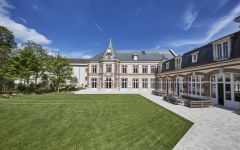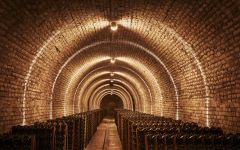Krug Brut (1.5 Liter Magnum) 1996
-
Wine
Spectator

Product Details
Your Rating
Somm Note
Winemaker Notes
Krug Vintage is designed to blend vintage character with Krug's house style. Krug selects young fermented wines which best represent the character of the particular year. The three grape varieties are blended to create harmony: Chardonnay's elegance, Pinot noir's fullness and the fruit of carefully selected Pinot meunier grapes bring finesse and complexity to the wine. 1996 was also a landmark in the long history of the House of Krug, since Krug 1996 was the last vintage to be blended by three generations of the Krug family–Paul Krug, Henri and Rémi Krug, and Olivier Krug–all working together. Olivier Krug, Directeur de la Maison Krug, clearly remembers his grandfather's reaction when he first tasted the year's newly fermented wines. "Throughout his life, my grandfather shunned exaggeration of any kind," he says, "but on this occasion he looked at us and said: 'I think this may well be the next 1928'. Eleven years on, Krug 1996 is certainly a Krug to the power of Krug. Time will tell if it is indeed a legend in the making."
99 points
"A powerful, majestic Champagne. Deep and compelling, with aromas of whole-grain toast, coconut and dried citrus that draw you in. Lean and racy on the palate, with a creaminess that's yet to be integrated. A classic ‘96, with ripe, exotic aromas and a steely structure. Still a baby, with the long resonant finish confirming its potential. Best from 2009 through 2040."
Wine Spectator
99 points
"Light gold. Remarkably perfumed nose projects an exotic bouquet of deep, leesy yellow fruit, minerals, honeycomb, smoked meat and flowers, with Asian spices building expanding in the glass. Almost painfully concentrated, offering a surreal parade of orchard and pit fruits, smoked meat, toasted brioche and marrow braced by intensely salty, stunningly incisive minerality. Imagine a Frankenstein's monster of Chablis Le Clos and Clos Ste. Hune-but one with perfect balance, of course-and you get an idea of what I found in my bottle. The energetic, stony character builds exponentially on the finish, which didn't seem to, well, finish. The best analogy I can come up with for the intensity, focus and clarity of this Champagne is liquefied barbed wire. Utterly hallucinatory and one of the most amazing wines I've ever been fortunate enough to drink. At the risk of sounding completely out of touch with reality, this is a value."
Stephen Tanzer's
International Wine Cellar
Professional Ratings
- Wine Spectator
Other Vintages
2008-
James
Suckling -
Wine
Spectator -
Wine
Enthusiast - Decanter
-
Wine &
Spirits -
Robert
Parker
- Decanter
-
Wine
Spectator -
Robert
Parker -
James
Suckling -
Wine &
Spirits
-
Robert
Parker -
James
Suckling - Decanter
-
Wine
Spectator -
Wine &
Spirits
-
Wine
Spectator -
James
Suckling - Decanter
-
Wine &
Spirits
-
Wine
Enthusiast -
Wine &
Spirits -
James
Suckling -
Robert
Parker -
Wine
Spectator
-
James
Suckling -
Wine &
Spirits -
Wine
Spectator -
Robert
Parker
-
Wine
Spectator -
Wine &
Spirits -
Robert
Parker
-
Wine
Spectator -
Wine
Enthusiast -
Wine &
Spirits -
Robert
Parker
-
Wine
Spectator -
Wine
Enthusiast -
Wine &
Spirits
-
Wine
Spectator -
Wine
Enthusiast
- Decanter
-
Wine
Spectator -
Wine &
Spirits -
Wine
Enthusiast









Krug has always lived up to its reputation as the first and only Champagne House to create exclusively prestige Champagnes every year since its foundation.
The House was established in Reims in 1843, by Joseph Krug, a visionary non-conformist with an uncompromising philosophy. Having understood that the true essence of Champagne is pleasure itself, his dream was to craft the very best Champagne he could offer, every single year, regardless of annual variations in climate. Paying close attention to the vineyard’s character, respecting the individuality of each plot and its wine, as well as building an extensive library of reserve wines from many different years allowed Joseph Krug to fulfil his dream.
With a very original approach to Champagne making, he decided to go beyond the notion of vintage to create the most generous expression of Champagne, every year. Thus, he founded a House in which all Champagnes are of the same level of distinction.
Six generations of the Krug family have perpetuated this dream, enriching the founder’s vision and savoir faire.
Further elaborating on the notion of individuality, for Krug’s Cellar Master Julie Cavil, each plot of grapes, through its wine, is like a single ingredient to a chef: carefully selected, and critical to the final composition. Each year, Krug honors this philosophy by inviting chefs from around the world to interpret a single ingredient, crafting unexpected recipes to pair with a glass of Krug Grande Cuvée or Krug Rosé. This year’s ingredient is the Onion.
The unspoken onion is a key component of almost every fundamental recipe from stocks, sauces and stews to baked goods and roasts. Its multifaceted expressions beautifully marry both the fullness of flavors and aromas of Krug Grande Cuvée the elegance and boldness of Krug Rose.

Representing the topmost expression of a Champagne house, a vintage Champagne is one made from the produce of a single, superior harvest year. Vintage Champagnes account for a mere 5% of total Champagne production and are produced about three times in a decade. Champagne is typically made as a blend of multiple years in order to preserve the house style; these will have non-vintage, or simply, NV on the label. The term, "vintage," as it applies to all wine, simply means a single harvest year.

Associated with luxury, celebration, and romance, the region, Champagne, is home to the world’s most prized sparkling wine. In order to bear the label, ‘Champagne’, a sparkling wine must originate from this northeastern region of France—called Champagne—and adhere to strict quality standards. Made up of the three towns Reims, Épernay, and Aÿ, it was here that the traditional method of sparkling wine production was both invented and perfected, birthing a winemaking technique as well as a flavor profile that is now emulated worldwide.
Well-drained, limestone and chalky soil defines much of the region, which lend a mineral component to its wines. Champagne’s cold, continental climate promotes ample acidity in its grapes but weather differences from year to year can create significant variation between vintages. While vintage Champagnes are produced in exceptional years, non-vintage cuvées are produced annually from a blend of several years in order to produce Champagnes that maintain a consistent house style.
With nearly negligible exceptions, . These can be blended together or bottled as individual varietal Champagnes, depending on the final style of wine desired. Chardonnay, the only white variety, contributes freshness, elegance, lively acidity and notes of citrus, orchard fruit and white flowers. Pinot Noir and its relative Pinot Meunier, provide the backbone to many blends, adding structure, body and supple red fruit flavors. Wines with a large proportion of Pinot Meunier will be ready to drink earlier, while Pinot Noir contributes to longevity. Whether it is white or rosé, most Champagne is made from a blend of red and white grapes—and uniquely, rosé is often produce by blending together red and white wine. A Champagne made exclusively from Chardonnay will be labeled as ‘blanc de blancs,’ while ones comprised of only red grapes are called ‘blanc de noirs.’
